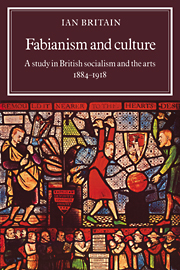Book contents
- Frontmatter
- Contents
- Preface
- List of abbreviations
- Introduction
- PART I THE LITERARY AND ARTISTIC ORIGINS OF FABIAN SOCIALISM
- PART II ART, AUSTERITY AND PLEASURE IN FABIAN SOCIALISM
- 5 The Webb partnership: the practice of renunciation
- 6 The Fabians as anti-ascetics
- 7 Powerhouse or club?: artistic activities of the Fabian Society
- 8 Platform or playhouse?: Fabian lecturing on the arts and the arts of Fabian lecturing
- PART III FABIANISM, ÉLITISM AND POPULAR CULTURE
- Conclusion
- Notes
- Bibliography
- Index
5 - The Webb partnership: the practice of renunciation
Published online by Cambridge University Press: 29 September 2009
- Frontmatter
- Contents
- Preface
- List of abbreviations
- Introduction
- PART I THE LITERARY AND ARTISTIC ORIGINS OF FABIAN SOCIALISM
- PART II ART, AUSTERITY AND PLEASURE IN FABIAN SOCIALISM
- 5 The Webb partnership: the practice of renunciation
- 6 The Fabians as anti-ascetics
- 7 Powerhouse or club?: artistic activities of the Fabian Society
- 8 Platform or playhouse?: Fabian lecturing on the arts and the arts of Fabian lecturing
- PART III FABIANISM, ÉLITISM AND POPULAR CULTURE
- Conclusion
- Notes
- Bibliography
- Index
Summary
In laying the weight of their emphasis on the preparatory methods — largely economic in nature — by which the general reordering of society was to be brought about, the Fabians did not lose sight of their ultimate aesthetic and cultural aims. Nor did they completely relinquish the personal interest in art which they had developed in the days before they became socialists. This is undeniable in the case of Shaw. The case of the Webbs is rather more complicated. Their concerns with art have been explicitly denied by many commentators, or acknowledged only in the case of Beatrice before she met Sidney. Once the Fabian partnership began, it has been argued, she turned her back on artistic interests or creative pursuits, partly out of deference to her husband's distaste for them. That distaste has been greatly exaggerated, as can be seen from the breadth of Sidney's own early interests in the arts. Misunderstandings concerning his attitudes to the arts have been compounded by a highly selective reading of the evidence relating to the years which followed his conversion to socialism. If this evidence is examined more thoroughly, it will be found that his attitudes did not differ substantially from Shaw's.
Webb acknowledged on various occasions the limitations of his aesthetic sensitivities and experience, but these claims should not be taken as pointing to an inherent narrowness of mind or a complacent indifference on his part.
- Type
- Chapter
- Information
- Fabianism and CultureA Study in British Socialism and the Arts c1884–1918, pp. 113 - 142Publisher: Cambridge University PressPrint publication year: 1982

